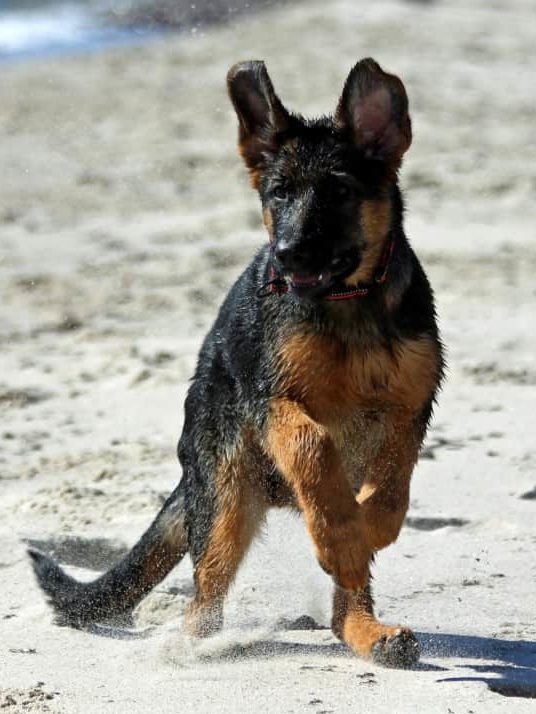If your German Shepherd has not been paying attention to your commands, you might be wondering if he is being stubborn. Alternatively, you might doubt his training and wonder how you can train a disobedient German Shepherd.
To train a disobedient German Shepherd, you must first exhaust his excess energy with walks, playtime, and socialization. Then use reward-based training and follow a training schedule. Never scold your German Shepherd for disobedient behavior, as negative attention can also be seen as a reward by anxious dogs.
Top Tips on How to Train a Disobedient German Shepherd:
- Use positive reinforcement techniques.
- Increase socialization.
- Ensure your GSD is sufficiently exercised.
- Provide varied mentally stimulating and fun games.
- Increase training sessions.
- Train your German Shepherd in a distraction-free setting.
- Provide various chew toys to relieve boredom.
- Follow a training and feeding schedule.
- Avoid adverse punishment.
- Ignore demanding behavior.
- Use brief and effective time outs.
- Brush your GSD 2-3 times a week to increases bonding.
- Attend obedience classes or consult a professional trainer.
In this post, you will learn over 13 different ways to quickly manage the problem of your German Shepherd not listening. First, you will find out key indicators of a disobedient dog, and under each, several ways to manage the respective symptom.
I’ll then cover in more detail exactly how to train a disobedient German Shepherd.

Why is My German Shepherd Disobedient?
Your GSD Has Pent-up Energy
If your German Shepherd’s disobedience manifests itself in the form of clawing and biting furniture, walls, and flooring, then he has reserves of surplus energy that need to be exhausted.
The German Shepherd’s metabolism is geared towards work, and while they’re not used as working dogs in a family context, you should take them on daily walks so they don’t get frustrated.
Signs Your GSD Has Pent-up Energy
- Bites, claws, and gnaws furniture and abrasive surfaces.
- Sprints back and forth across short distances.
- Has a serious case of the “zoomies.”
- Refuses to get into his crate.
How To Manage This:
- Take your GSD on long walks.
- Play fetch or frisbee.
- Allow off-leash running in a safe environment.
- Play hide and seek with your GSD.
Your German Shepherd Is Attention-deprived
Sometimes, it is easy to consider German Shepherds’ material needs and forget that they are emotionally intelligent creatures who get hyper attached to their owners. If you haven’t given your German Shepherd proper attention and appreciation for being a good boy, he might start experimenting with being a bad boy.
Acting out is one way German Shepherds like to gain attention, which is reminiscent of teenage children.
Signs Your GSD Is Attention-deprived
- Your German Shepherd barking louder than usual is a warning sign that your pup has a behavior problem.
- Acts hungry even when fed and lingers around you when you fill his bowl.
- Gets irritated with anything associated with your departure (picking up keys, the doorbell, and even specific words).
- Brings you toys, random items and claws your chair while you’re seated.
How To Manage This:
- Ignore demand barking or other demanding behavior.
- Brush your German Shepherd 2-3 times a week. This can be a great bonding experience.
- Play in a distraction-free setting.
- Extend your allocated time to focus on your dog.
Your German Shepherd Is Not Properly Trained
One of the most significant contributors to a GSD’s disobedience is the lack of proper training. If your commands don’t stick and your German Shepherd acts as if he doesn’t hear you, the chances are, he doesn’t have appropriately set anchors for appropriate behavior and command-response.
This can happen if responses to commands aren’t rewarded enough, mistimed, or if you’ve previously called your GSD then scolded him, causing confusion.
The latter only associates obedience with punishment. This is the most challenging cause to fix as it requires making the German Shepherd unlearn what he has previously deduced, then training him to behave correctly.
Signs Your GSD Isn’t Trained Properly
- Doesn’t respond to specific commands, such as “SIT” or “STAY.”
- Has poor recall.
- Steals food.
- Barks at other dogs or pulls on the leash.
- He lunges or jumps up at people, or jumps at you.
How To Manage This:
- Start reinforcing previously set anchors with reward.
- Increase socialization opportunities.
- Ignore him when he misbehaves or redirect poor behaviour.
How To Train a Disobedient German Shepherd
Now that you know why your dog doesn’t listen to you, let’s now explore how to train your disobedient German Shepherd.
1. Use Positive Reinforcement Techniques
Positive reinforcement, also known as rewards-based training, implies giving a reward to increase the frequency of the response. Rewards can be:
- Treats. Choose healthy treats, pieces of kibble, or tiny pieces of meat.
- Physical attention. You can pet behind the ears or give a hug.
- Verbal praise. An enthusiastic “YES!” or “GOOD DOG!”
- Toys. Give your GSD his favorite toy that you save for rewards.
Rewarding your German Shepherd for good behavior is an underrated tool in your dog-training arsenal. It is simple yet incredibly powerful. Unfortunately, it is also often ignored.
No dog acts up 100% of the time, and if dog owners can just be patient until a dog is calm and reward the restrained behavior, they would see their canine friend magically morph into a more obedient dog.
Nested within this step is the following principle: do not reward your dog with negative attention.
German Shepherds can sometimes prefer to get negative attention than to be ignored entirely.
If your GSD doesn’t get enough affection and appreciation, he might get anxious and act out to receive attention. If you scold him, he might feel content for having received your attention.
This speaks to the importance of patience; the more patient you are, the more your German Shepherd values positive attention.
When you bestow it upon him during his calmer episodes, he starts recreating the setting. You will notice him sitting in the same place where you patted him or held a similar position.
It might be tempting to pet him then, but you have to be patient, or you will confuse the dog. Wait until he mimics the actual calmness you want to reward, then use reinforcement by giving him attention, affection, and treats.
2. Increase Socialization
If you have previously delayed socializing your German Shepherd, the chances are that the lack of socialization is a key contributor to his disobedience.
You should socialize a German Shepherd at 8 weeks old, which is usually when you bring your puppy home.
Your breeder would have already begun early socialization from 3 weeks, so you should now continue the process of exposing your pup to a range of sights, smells, sounds, and interactions with people and other dogs.
No matter whether your doggo is a pup or an adult, increasing socialization will set your German Shepherd on the right path to becoming a confident, friendly and obedient dog.
I have a great article on how to socialize a German Shepherd from pup to adult. This details easy ways to go about this and includes how to socialize an older dog or even an aggressive German Shepherd.
3. Ensure Your GSD is Sufficiently Exercised
This isn’t as much a “training” aspect as it is a way of making your dog training-ready. When your German Shepherd has pent-up energy, he might not be in the state to receive commands.
By sufficiently draining this excess energy safely and productively, you can make your German Shepherd more receptive and less stubborn. In this state, you can reinforce restraint-centric anchors.
That said, you must not wait until the dog is in his most agitated state before you take him out, as that would associate acting up with freedom, and he will almost always act out to be taken for walks or playtimes. Instead, prevent it in the first place.
If you have a young pup and need some ideas, check out this article, 7 Fun Ways to Exercise a German Shepherd Puppy.

German Shepherds are high-energy dogs, and adults need at least 1-2 hours of daily exercise. It’s best to split activities into two sessions, morning and late afternoon.
In addition to essential exercise for your German Shepherds to stay obedient, he also needs to be mentally stimulated, which brings me to the next solution.
4. Provide Varied Mentally Stimulating and Fun Games
We have to remember the original purpose of the German Shepherd, which was to herd and protect livestock. Although rarely used in this capacity nowadays, the genetic working trait remains with the breed.
They need a job to do and thrive off pleasing their owner, which is why they are used in law enforcement, search and rescue, and as service dogs today.
Every evening around 8 pm, my German Shepherd will sit in front of me and give me the stare! That’s her cue that it is playtime.
Taking her for a walk just isn’t good enough as she wants to interact, think for herself, solve puzzles, and play games such as hide and seek.
You can also get interactive games from Amazon, such as the Outward Hound Interactive Treat Puzzle Toy. I love this toy, and dogs enjoy finding the treats in the puzzle toy, which keeps them busy for ages.
Note: Clicking the above link(s) will take you to Amazon or an online store where we have an affiliate relationship. If you make a purchase, we may earn a commission at no additional cost to you.
5. Increase Training Sessions
Similar to socialization, if you have previously delayed training your German Shepherd or if training is incomplete, the chances are that the lack of training is a pivotal contributor to his disobedience.
Not only does your German Shepherd need to learn that he should listen to you, but he must also find out what listening to you entails.
While the best time to start training your GSD is at 8 weeks old, the next best time is now. However, you must avoid matching your dog’s training with age because a one-year-old untrained German Shepherd has to learn everything a puppy must learn before he is ready for specifics like verbal commands.
When increasing training sessions whilst working on your German Shepherd’s stubbornness, little and often is best.
That means short 3-5 minute training sessions regularly throughout the day. This will keep your dog continually focused and interested.
Your German Shepherd must also learn his position. Suppose your dog has accepted you as a guardian, but commands haven’t been appropriately anchored.
In that case, you’re in luck because all you need to do is be patient as you gradually train him, with positive reinforcement and rewards, to follow individual commands.
If your German Shepherd hasn’t accepted you as his guardian, you have a more challenging path ahead. You’ll need to be more assertive and show dominance to your GSD without crossing the line of compassion and kindness.
6. Train in a Distraction-Free Setting
If your German Shepherd has selective hearing when you’re at the dog park or disobeys his recall command as he finds it more fun to chase a squirrel, you need to start with the basics. This entails going back to training in a distraction-free setting.
The probable explanation for your German Shepherd’s disobedience is that he is overwhelmed by his environment with too many interesting and exciting things going on.
He might not intend to ignore you deliberately, so this is where you need to get him to focus his attention on you. Here’s how you do this:
- Start off by slowly building distractions in the house, then build up.
- Work on commands such as “LEAVE IT,” or “WATCH ME,” or “HEEL.”
- Teach your German Shepherd to focus on you.
- Manage the environment when progressing outside. Start off with not too many distractions.
- Use high level treats when outside.
Check out this excellent video on how to train a German Shepherd with distractions. This gorgeous pup is only 5 months old and is learning to focus on the trainer in a controlled outside environment.
Notice how the trainer gets rid of the pup’s excess energy allowing him to be more focused and obedient.
7. Provide Various Chew Toys to Relieve Boredom
It’s a fact that all dogs love to chew, and German Shepherds are no exception. Chewing has several functions, including providing pain relief for teething pups, keeping teeth clean and jaws strong in older dogs, and relieving boredom. Dogs just enjoy chewing.
But what if the chewing becomes destructive?
Destructive chewing occurs when there’s a lack of training, separation anxiety sets in due to boredom and frustration, or attention-seeking. Providing your dog with a chewing outlet, such as various interesting chew toys, will stop many German Shepherd behavior problems.
The concept is similar to the need to provide sufficient physical and mental exercise for your dog in that it’s an additional way to rid your German Shepherd of his pent-up energy. The happier your doggo is, the less stubborn he will be when it comes to obeying you.
Choose something like the KONG variety of chew toys. I like the KONG classic from Amazon as it’s not only great to chew, but it’s a multi-functional toy in that you can also use it as a fetch toy, and you can stuff it with treats such as peanut butter or biscuits.
8. Follow a Training and Feeding Schedule
Having a schedule provides structure and discipline and teaches your pup that you are the leader. Puppy training schedules should ideally start at 8-weeks old, but if you’re struggling with what to teach and when, or even if your dog is a little older, check out my German Shepherd puppy training schedule.
Don’t worry if you’ve not started at 8 weeks; start with the basics and work through them. Your German Shepherd will soon pick things up and catch up.
You should also stick to a feeding schedule. Dogs are creatures of habit, and providing meals at expected times means listening and obeying you when you call them to eat.
German Shepherds are prone to sensitive stomachs, and many are not food motivated, unlike the Labrador. Having a feeding schedule also prevents your German Shepherd from becoming a fussy eater.
9. Avoid Adverse Punishment
Studies have shown that using adverse-based methods only harms your dog’s welfare. Tactics such as yelling, physical punishment, using the “alpha-roll,” tying your dog up for long periods, extended time-outs, etc., are certainly not the right ways to train a disobedient German Shepherd.
These “techniques” will only have the opposite effect of solving your German Shepherd’s stubbornness in that they will make him aggressive, fearful, stressed, and cause distrust of you.

This study found that “those working with or handling dogs should rely on positive reinforcement methods and avoid using positive punishment and negative reinforcement.”
10. Ignore Demanding Behavior
So, your German Shepherd is not listening to you when you tell him “NO,” and he continues to engage in demanding behavior, such as barking, pawing, or jumping up at you. It might be that he wants that extra treat or wants to climb on the couch.
So now the tide is turned. Instead of your dog ignoring you, you now ignore your dog.
Never bow down (pardon the pun) to any form of demanding behavior, especially demand barking. This will only teach your best friend that he gets what he wants when he barks for something.
Instead, ignore the demand barking, and at the precise moment he becomes quiet, quickly reward him with a treat. That way, he will soon learn that when he stops barking at you, nice things will happen.
The trick here is in the timing. That’s why it’s best to have some treats in your pocket at all times when training a disobedient German Shepherd.
11. Use Brief and Effective Time-Outs
When training a stubborn German Shepherd, one of the most crucial steps is teaching your dog to accept time-outs.
Rewarding your doggo with treats is easy; it is in discipline or punishment, where most people mess up. You must teach your German Shepherd to follow your commands – or ground himself.
Tip: Learn the do’s and don’ts of how to discipline a German Shepherd
So, what do I mean by a time-out?
A time-out is a type of negative punishment in which we deprive the dog of what they enjoy, in this case, social engagement.
Teach your German Shepherd to follow the “GO” or “TIME-OUT” command and go to a secluded area. But there are a few rules you must follow:
- Never use your pup’s crate for time-outs.
- Use an area of the house, a room with a dog gate, or an exercise pen for young pups.
- Time-outs should be around 60 seconds for young puppies to 2-3 minutes for older dogs.
- Use the time-out at the moment of the stubborn behavior, not after.
- Don’t put your GSD in a room and close the door as this creates a negative experience.
12. Brush Your GSD 2-3 Times a Week to Increase Bonding
German Shepherds are known to be a heavy-shedding breed. But not only does regular brushing help to control and reduce shedding, but it also helps to increase bonding between you and your pet.
Most dogs enjoy being the center of attention. Brushing is relaxing and beneficial to the skin and hair.
Your German Shepherd will also learn that it is acceptable to handle his body and feet, and you will develop trust with your canine buddy as a result.
This has the everlasting effect of reducing his stubbornness when you need to clip his nails or he needs to be handled by the vet.
You should brush and de-shed your German Shepherd at least 2-3 times per week and more in the spring and fall when he is “blowing” his undercoat. Go here to find out the best grooming tools for German Shepherds and the ones I use.
13. Attend Obedience Classes or Consult a Professional Trainer
If you’re still struggling to train the stubbornness out of your German Shepherd, don’t worry, as you can enlist him into obedience classes. This will give you peace of mind that he will respond to you positively and help curb any bad habits.
Often, inexperienced owners just need to be taught what to do. Attending obedience classes solves this knowledge gap and creates an opportunity to increase socialization, so you kill two birds with one stone.
You can also enlist the help of a professional trainer as they will be experienced in training stubborn dogs and improving obedience.
Key Takeaways
German Shepherds are socially intelligent dogs. However, with delayed or insufficient training and a lack of guidance, they can become asocial and disobedient.
Fortunately, with enough patience, firmness, and positive reinforcement training alongside increased exercise time and stimulation, any German Shepherd can be brought back into the socially acceptable circle of obedient dogs.





